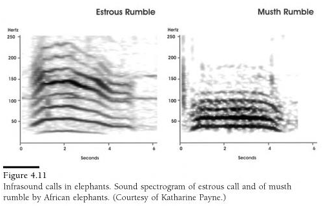Elephants
& Siesmic Communication
Stuart Steidle & Sara Post ~ Reed Bio 342
| Home | Phylogeny | Ontogeny | Mechanism | AdaptiveValue | References | CourseHome |
What are the advantages of communicating seismically?
In addition to being able to use infrasonic frequencies to locate a parent or offsping, low frequency calls have also been found to occur when an elephant is attempting to attract a mate. The rate of calling increases with the number of potential mates present, during which females also utilize seismic communication (Fig1). It is thought likely that elephants compete for a mate using the strength of their call. The figure below shows that elephants during mating season surrounded by a large group of elephants have a higher call rate than when alone.
Fig 1. Number of elephants vs. Call rate (calls/minute) showing that there exists a general progression of call rate and number of nearby elephants. (Poole, Payne & Langbauer)Gender signal differences:
Male elephants (bulls) as well as females move over many miles of territory during a year with no fixed breeding season. Elephant males spend a part of every year in musth. During this time, the male agitatedly traverses large areas in search of a mate. Elephant females have a two year gestation period with two or more years of nursing, meaning a female will only be receptive for a few days every four or five years and that a male must locate her quickly.
Males easily locate females during the mating season with infrasonic communication. Once found, the dominant male in musth will guard the female in order to mate every few hours until her receptivity ends. Payne’s research showed that the female is capable of sending males a series of infrasonic calls during this time. “The rumbles begin as slow and deep, but rise in pitch to become stronger and higher. At the highest pitch, the rumbles begin to sink until reaching silence” (Payne, 1986).
Fig 2. Infrasonic calls in females vs. males (Poole, Payne & Langbauer)

